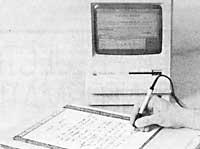To reject the keyboard of computers?
1987/02/01 Elhuyar Zientzia Iturria: Elhuyar aldizkaria
Seeing that those engaged in computer tasks strive to type with two or three fingers and without removing their eyes from the keys, it cannot be said that the keyboard is the most suitable tool. It seems that the French have found a solution to this problem: reject the keyboard.
When three years ago Xavier Maury set out to develop a system that would allow the analysis of manuscript texts by a microcomputer, it seemed impossible. The specialists assured that it could only be done on large machines, but Mr. Maury followed his work without paying too much attention to all this. After analyzing the problem well, he came to the solution with an empirical method. We begin to devise some tools for the analysis of the information stored in a Numerical Table with a list of coordinates.
One corresponding to the closed curve, another corresponding to a single softening or relative dimension. In this way, he formed a bank of images or shapes in which all letters, digits and signs appeared, which were hidden by the list of coordinates. When the program was requested to identify any of the characters written in the numerical table, the aspect of this character was compared with all the images or shapes of the bank, at best the correct character appeared.

The character, once identified, was displayed on screen and saved in the ASCII code of a file. But the problem didn't end there, because in normal writing letters are linked together. To identify the characters, the number of reviews and time had to be greatly increased.
Faced with this situation, the engineers working on this work decided to accept certain ambiguities and give the program a self-teaching capacity. Thus, if the existing criteria or models were not enough to identify a given character, an error occurred. Correction made by the user, saving between the programs and their previous reviews. Following this method, the more the program is used, the less errors.
How does Personal Writer appear for the user? The program begins with an adaptation session in which you will learn the characteristics of the writer's writing. This process consists of reproducing two or three pages for further analysis. The results obtained from this analysis will be stored in the aforementioned data bank, as well as the criteros of each letter and sign. From this moment on, if writing is regular, the program can read it without errors. But this case is not the most common.
Therefore, it obliges us to foresee other scriptures. This customization of the program forces you to create your own image bank. Once this first learning is done, the user can switch to other options. If you want to use text processing, simply open your own image bank. You will also have at your disposal the keyboard and all the commands and options available with the xagua (menus, internalization, correction, etc. ). ).
Moreover, a 200,000 word dictionary can be incorporated into the program. It will check whether or not the identified letter group matches any of the dictionary words; if they have the difference of a single letter, it may be an error. Then the program will choose the word that comes closest and you will have the possibility to correct the spelling error.
But let's not dream: the correction of syntactic errors is not yet in the hands of the Personal Write; let's not think that the text that a qualified person cannot read is read by Personal Writer. Therefore, this innovation will not be widely disseminated among physicians.
However, it is able to easily read texts written with italics and with normal speed. The number of errors, compared to keyboard errors of an operator who does not know typing, is lower. On the other hand, all programs will be useful without the need for keyboards or xagas.
Personal Write is still not on the market. The Macintosh Plus version and IBM PC compatible version over the next six months will be on the street after the last adjustments of the first quarter of the year. The only drawback can be the price, ranging from 12,000 to 15,000 francs, including programs and digitizing table.

Gai honi buruzko eduki gehiago
Elhuyarrek garatutako teknologia





